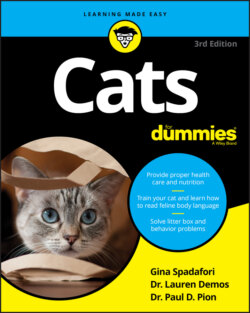Читать книгу Cats For Dummies - Gina Spadafori - Страница 28
Characteristics by Breed
ОглавлениеPedigreed cats are roughly divided by experts into two groups that are distinguished by body type and activity level.
The breeds in the first group, the Oriental, are notable for their long, sleek bodies and active participation in the world around them. They’re not happy unless they’re supervising dinner, climbing to the top of the bookshelf, teasing that dopey dog, or seeing what every member of the household is up to. The way these cats see the world, you’re not capable of running your own life without their help. Cats in this group, such as the Siamese, and Abyssinian, are often touted as being more intelligent and trainable, as well as the Oriental Shorthair, basically a Siamese coat but with a broader range of coat patterns and colors.
The non-Orientals see things a little bit differently. If you’re big and beautiful, the world comes to you with all your needs. Why interrupt a good nap to see what’s on top of that bookshelf? Cats in this group, such as the Persian, Ragdoll, and British Shorthair are generally happy to sleep in your lap while you read — and not bat at the pages as you turn them!
At first, the differences between these breeds may also seem to relate to their coats, with the sleek shorthairs falling in the Oriental group and thicker-set longhairs in the other. That assumption would be true except for the work of those who want to offer you even more options in a cat, such as longhaired versions of the Siamese (the Balinese) and Abyssinian (the Somali) and a breed that’s pretty close to a shorthaired version of the Persian (the Exotic).
The history and legends behind the various breeds of pedigreed cats are almost as interesting and colorful as the cats themselves. Two books that are good jumping-off points for more in-depth research into cat breeds are The Cat Fanciers’ Association Cat Encyclopedia (Simon & Schuster) and Cat Breeds of the World: An Illustrated Encyclopedia, by Desmond Morris (Viking). The handful of registries of pedigreed cats all have websites that provide additional information on the breeds in each association.
Unlike purebred dogs — who are divided roughly by purpose: sporting, herding, and so on — pedigreed cats aren’t quite so easy to categorize. Not surprisingly, really, if you consider that each cat himself is unique — and if you don’t believe it, just ask him!
Not happy with the two divisions the experts offer, we break down the various breeds into categories, a task almost as difficult as herding cats themselves. The breakdown’s not perfect — some longhaired cats are also among the largest, for example, and some of the more active breeds are also distinctive in other ways. (In such cases, we list the breeds twice, once in each category.) But we figure that breaking the almost 50 breeds down into categories would make thinking about what sort of breed you may want a little easier.
